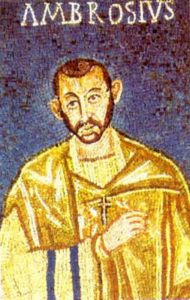 Do you enjoy singing hymns in church? Then thank Saint Ambrose; he is generally credited with introducing hymnody into the Western church from the East. And that was only one of his many accomplishments.
Do you enjoy singing hymns in church? Then thank Saint Ambrose; he is generally credited with introducing hymnody into the Western church from the East. And that was only one of his many accomplishments.
Ambrose was born around 340 and raised in Trier in present-day Germany. His father was a praetorian prefect (an administrator of justice), and his mother was known for her intellect and her piety. Like his later protege, Augustine, Ambrose showed intellectual promise early in life. He was educated in Rome and was elected Bishop of Milan at age 34. He had to be hastily baptized before he could take the job. Late-life baptism was common in early Christianity and Ambrose hadn’t gotten around to being baptized yet when he was elected bishop!
I selected the above image of Ambrose from among many choices, because it seemed the closest to descriptions of what he looked like. He is said to have been small and frail, with very large eyes and a melancholy face.
Ambrose may have been physically small and weak, but his character was mighty. In 386, the emperor’s mother demanded that Ambrose cede control of two Milan churches to followers of the Arian heresy (short version: Arians denied that the Son was co-eternal with the father; people got very excited about these things in the 4th century). Ambrose refused, barricaded himself in one of the churches, and got most of the Christians of Milan on his side – including the emperor’s own troops, who surrounded the church protectively. Ambrose prevailed over the imperial family, and the churches remained in the hands of the Catholics.
Ambrose was also known as a powerful and persuasive speaker, with a voice out of proportion to his small stature. His sermons were sensational entertainment. During her time in Milan, Saint Augustine’s mother, Saint Monica, befriended Ambrose, and Ambrose is generally given a lot of credit for finally converting Augustine to the Christian faith. Augustine admired Ambrose’s wisdom and learning. He was awed by Ambrose’s ability to read silently. This was unusual in the 4th century. Most people who could read, read aloud, even when they were alone. It was Ambrose who persuaded Augustine to accept the Christian Bible, by explaining that it should not always be taken literally but should instead be read for deeper truth. Thus, we may owe to Saint Ambrose, a great man himself, the conversion of one of the greatest fathers of the Church.
Saint Ambrose’s body was preserved and can still be viewed at the Basilica of Sant’Ambrogio in Milan. My husband and I saw it there in 2009, when I was doing my research for The Saint’s Mistress – along with the remains of Gervasius and Protasius, of whose authenticity Augustine is initially skeptical in my book.
